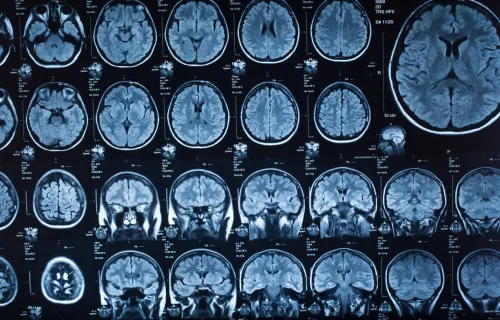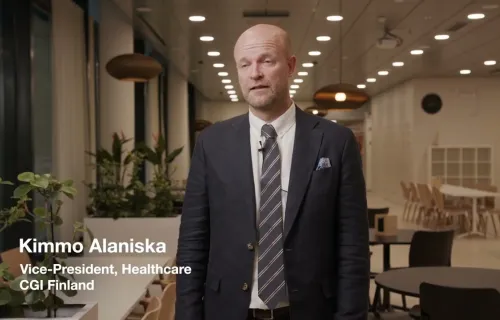Russell Goodenough: Hi there, everybody, and welcome to another podcast from CGI. This time, my name is Russell Goodenough, and I'm Head of Artificial Intelligence for CGI's business in the UK and Australia. I'm joined today by Diane Gutiw, who is the leader for our global artificial intelligence research team. Hi there, Diane.
Diane Gutiw: Hi, good morning, Russell. How are you?
Russell: Hi. Good morning to you. Good afternoon from here in the UK. Of course, you're joining us from British Columbia. We're very grateful to have you on this podcast. Today, we're going to spend a little bit of time talking about the subject of artificial intelligence. Of course, we're not the only people talking about AI. There's been an awful lot of hype about AI over the last, it's a couple of years now. In a business context, I think most people I'm speaking to most recently are starting to get a little bit bored about horizon scanning.
They want us to talk about the real practical areas where artificial intelligence is starting to make a difference. Diane, would you agree with me? Where is it starting to be used really in earnest?
Diane: Yes, it's a great point, Russell. That's what we're really starting to hear in conversations that we're having with leaders in public sector, private sector is, there was a lot of discussion on generative AI over the last couple of years. It was quite revolutionary, not only in what it was able to do by generating information from documents and images and videos and all kinds of new media. What we're starting to hear now from business leaders is, let's stop talking about the technology and let's focus more on the problems and what that technology or which technology can be used to be able to help solve some of these hard problems.
Switch the topic from technology to practical application and where there's real value. To answer your question, where we're starting to see early value is not only in the generative AI, which has some fantastic use cases for being able to search and interrogate organizational documents and images and be able to create new documents and images. Be it contracts or proposals or any other kind of organizational intelligence, but the combination of generative AI with existing legacy AI solutions like expert systems, predictive models, and deep learning, really is where we're starting to see some value.
A great use case that I know you and I have talked about quite a bit is the Helsinki Head AI. For me, that's one of the fantastic solutions that really is saving lives, where they're using AI to assist radiologists in being able to detect early brain bleeds that are very hard to see with the human eye. Using that responsible use framework, the radiologist does the first read and then they're provided the AI-assisted read, which is really beginning to detect more and more early brain bleeds and saving lives. That's just one example.
I know we'll talk about a few other industries, but that's just such a great use case for where we really are making a difference. That return on investment is really life-saving.
Russell: That's a really good example. Obviously, it's delivering a load of benefits in terms of improving people's wellbeing. Do you think that is the first objective for most people who we talk to about AI for business? Is it really about saving money, or is it some other business benefit that people are interested in?
Diane: Yes, that's a great point as well. That is quite the extreme when we start looking at life-saving solutions for operations and productivity and efficiencies. Those are the sorts of words that you hear in conversations about, how can we get better efficiencies across our organization and use these tools to be able to do some of the more manual things that are quite difficult. A lot of the tools that are being rolled out that are integrated with our day-to-day productivity tools are starting to really see some uptake and some great benefits, whether it's the M365 Copilot, GitHub Copilot, or Code Whisperer.
These tools, while they're not going to by any means replace what we're doing, are a great assistance to be able to do things more quickly. A good use case for that would be what we're seeing with contact centers across a few different clients where we have a new contact center person. Rather than having to search for a solution to somebody's problem, whether it's an error on a technical piece of machine or an error in a computer system, if they're able to synthesize all the information across their training, their user guides, their past incidents, they're able to very quickly get an accurate, in-context answer to a question.
Which is really a brilliant use of some of these new technologies. Not just looking at documents but also being able to look at images. Does this part look correct? Is there a fault in this part where, again, it speaks to bringing together things like generative AI and computer vision where you're able to extend the benefit of that? You're absolutely right. Productivity, efficiencies, and tools to assist what we do on a day-to-day basis is really a lot of the conversations that we're having.
Russell: I guess that's one of the hard things for any senior person in business to navigate at the moment. It looks like the technology is going to change everything—from the way that you work with your own people, your own employees, to the way that you work with your clients, to the way that you even deliver business, the nature of your own business, and actually navigating that. It's a topic with massive breadth and depth and being able to have different touch points across, this is what benefit it's going to bring to your business really helps.
Diane: Yes, I think what you're going to start to see is it's going to get more seamless as well, and we'll start forgetting that that little co-pilot tool is AI. It'll just be another tool very similar to our spell check that we're able to use to be able to support the type of work that we do on a day-to-day basis. Some of the productivity increases, CGI has been doing our own productivity analysis against some of these tools, and we're seeing anywhere from 25% to 40% increase in productivity on individual tasks.
Certainly not in your full workflow in developing a document or a contract or a piece of code, but in the individual tasks that might have been very manual, usually looking things up or improving the quality of code or something like that. We're starting to see real benefits in those smaller individual tasks. I think as we get more familiar with these tools, it really will become seamless. As the conversation fades from AI to solutions, we'll start forgetting that it's AI, and it'll just be another tool that's going to help us get our work done more efficiently.
Russell: Yes, I can see that. That's becoming more apparent, and that AI is just going to be woven into every single thing that we do in our working lives and eventually in our family lives as well. I guess that brings me to the second part of the question really. If it's going to be so closely coupled with everything else that we do, if it's going to be so woven into our business lives and our home lives, presumably, then one of the biggest questions is navigating the opportunities and the challenges of integrating AI, new systems into legacy systems or new ways of working into old patterns of working.
Do you think that's a challenging area for us just at the moment?
Diane: Yes, I think what you're seeing and what we're doing as well at CGI is coming up with guardrails for responsible use. That involves not only how we develop solutions using AI to be assured that they're reliable, that they're transparent, that we know the source of information, they're secure, they're private, all of those things, but it's also making sure we're discerning humans. No different from when you do a Google search for the best Italian restaurant; you go down through the list and use your own ability to discern what the accurate answer and what the best-fit answer is.
I think we need to do that with our AI solutions as well, and that's what's going to help us be able to use these in a world where things are more AI-driven. We see a lot of training and a lot of discussion on prompt engineering, which really is just how you ask the question. The more precise you are in your question, the more precise the answer you get. It's no different with these tools that we're seeing for productivity, and it's also what we're going to see in how we integrate these solutions is being sure that how we apply it, how we ask the question is really focused on what that answer we want.
The other thing I think that's really critical as we see these things roll out and become integrated in a lot of our tools is to really understand what's the benefit we want to achieve and not just work with AI for the sake of AI, but to really identify this is the benefit we want from this. This is how we want to be more efficient or do something more streamlined or increase the quality, and then look at the solution after you're complete and did you get that benefit? To what degree did you achieve that benefit to make sure that there's a value in what we're investing in AI?
Russell: I guess what that means is because of the media hype, there's an awful lot of people who you could dip into for advice on how to bring AI to your particular context. The sort of individual, the sort of organizations that you'd want to be working with to help you on an AI journey are the sort of people who understand your business or understand your existing services, your existing work patterns, and how your business works with other organizations, perhaps citizens, perhaps other businesses.
It really means that in order to make value from AI, you'd want to partner with organizations that already understand your business.
Diane: Yes, I think that's important. That's another one of these best practices to not just have technical teams developing the solution, identifying the data to be used for training the models, and to be looking at the outputs. It really needs to be a collaboration across business and technology to be able to be assured that it's meeting the purpose. You're absolutely right. I think that AI and advanced analytics both have, over the last couple of decades, been designed to get closer to the business. This is another example of that.
The solutions that are out now using natural language make it much easier. A great solution that both you and I have been focused on, the digital triplet, is doing exactly that. It's taking complex solutions for monitoring in digital twins, which could be utilities or healthcare, where we're already using technology and AI to look at different scenarios. When you add the new technologies of generative AI and large language models, you're able to use that natural language in a way that you can, again, interrogate what you're already getting out of your technology investment.
You can ask questions about what would happen if I changed a scenario using natural language and get the response in natural language. That's pretty groundbreaking for accessibility to these tools, which is really where we've seen this industry going over the last few years. Getting solutions that are able to speak to those business experts, including the business experts and the data experts in the development and design, and problem definition for these AI solutions is critical to make sure that it fits the need.
Then using the tools to be able to speak to those business experts so that they get the direct value without having to be heavy on the technical side is another huge benefit of what we're seeing now.
Russell: You introduced a couple of really interesting terms there, one of which was guardrails, which gets mentioned quite a lot. People tend to talk about the scary aspects of artificial intelligence, and it's always in the news. Should we really be afraid of AI when we're talking about it in the really practical terms that we have this afternoon?
Diane: Yes, and you and I both get that question quite a bit. AI is just a tool, and it's a tool that's designed to provide a solution. Anything that it does, even though these conversational tools sound like you're talking to something that has a brain, it's been coded to respond that way. I think going back to what we started this conversation with, let's stop talking about the technology and let's look at some of these really big problems, like the opioid crisis or social care crises. Where can we now do things that we could never do before with these tools?
That's exactly it. When you talk about guardrails, it really is ensuring AI for good. When we're looking at these big problems across our societies, that we now have the ability to take a look at larger amounts of information, synthesize it much more quickly, and look for examples of solutions that we may be able to apply, AI is a fantastic tool for that. It's nothing more. It's just a tool. It doesn't have a brain when it's answering your questions. No, I don't think that we need to be afraid of AI.
I think the guardrails help make sure that anyone working with AI or anyone developing these new AI solutions, because it is such an evolving technology, are working within a framework where they're really focused on AI for good. For some of those folks that are using AI in less positive ways, when you hear about fraud and deepfake and being able to use these tools for hacking, in parallel with that, the solutions that are helping us discern what is AI and what's not AI, you're going to see those evolve very quickly.
We've seen a few firms that are already starting to come up with solutions to detect AI and protect solutions from any AI attacks. I think when we use guardrails, we focus on AI for good. We remember that it's a tool that can be applied to a larger problem.
Russell: I think I very much agree with you. I don't think we should be afraid of AI. I think it is very much about the responsible use of AI. I do think the topic area is evolving extremely quickly, as you said, Diane. It's probably time for closing thoughts. However, given what I just said about this being a rapidly evolving area, I think it keeps changing. I'm not sure there is such a thing as a closing thought for an AI podcast. I presume this series will go on and on and on. Diane, do you have any closing thoughts for this particular discussion?
Diane: Yes, I agree with you. This is an evolving technology space. I don't think we're at the end of some of the really exciting things that are going to be coming out from these technology solutions. My last couple of thoughts are that AI is inevitable. We're starting to see it across everything from how we get packages delivered, how we're entertained, and how we work. I think people need to be discerning in what they're presented for information, the same way we do with a Google search. Then on the question that we hear all the time, should we be afraid of AI taking our jobs?
I don't think that there's any fear of AI taking our jobs. I think that people that understand how to work with AI are the ones that are going to have more opportunities in the future. Getting familiar with the tools, understanding how it's going to help you is really where we're going to start seeing a difference in how we work, rather than having these technologies replace us.
Russell: That's brilliant, Diane. Thank you very much, and everybody, we'll speak to you again.
Diane: Great. Thanks, Russell.
[END OF AUDIO]






